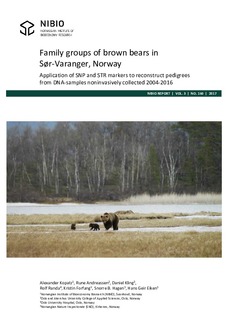| dc.contributor.author | Kopatz, Alexander | |
| dc.contributor.author | Andreassen, Rune | |
| dc.contributor.author | Kling, Daniel | |
| dc.contributor.author | Randa, Rolf | |
| dc.contributor.author | Forfang, Kristin | |
| dc.contributor.author | Hagen, Snorre | |
| dc.contributor.author | Eiken, Hans Geir | |
| dc.date.accessioned | 2018-06-28T07:02:49Z | |
| dc.date.available | 2018-06-28T07:02:49Z | |
| dc.date.created | 2017-12-12T10:08:16Z | |
| dc.date.issued | 2017 | |
| dc.identifier.isbn | 978-82-17-02006-6 | |
| dc.identifier.uri | http://hdl.handle.net/11250/2503431 | |
| dc.description.abstract | We reconstructed family relationships, parent-child and siblings, among the brown bear (Ursus arctos) sampled in Sør-Varanger, Norway. Basis of this study are observed family relationships by the wildlife management. We compared this strong indication of relatedness with testing particular family relationships using SNP- and STR-genotype data of 154 brown bears sampled mainly non-invasively in the area from 2004 to 2016. We calculated likelihood ratios (LRs) and reconstructed family groups with the program FAMILIAS, which was used to reconstruct family relationships in human forensics. When the LR of each relationship, parent-child or siblings, was tested, 40 (38.1%) relationships were confirmed based solely on genetic data. The allele sharing analysis visualized as dendrograms supported that a large proportion of the remaining observed cases that were not confirmed as parent-child or siblings did share a closer family relationship. More detailed analysis is necessary to deduce the nature of these relationships (cousins, uncle-nephew etc.). Based on the genetic data we found, that the minimum number of cubs per year was on average 4.08. The applied SNP-chip has been developed on the Swedish brown bear population, a population different to the bears living in Sør-Varanger. The performance of the SNP-chip in this study rises questions of its applicability for family analysis in other brown bear populations and shows the need for further evaluation of the individual loci on the chip. Nevertheless, the combined SNP-data from all loci seems to provide power enough to detect the previously reported subpopulation structure. The observational data, sampling effort and quality of the sample material of the brown bears in Sør-Varanger is remarkable and the material provides an excellent testing ground to validate and improve the SNP-chip to reconstruct family groups. | |
| dc.language.iso | eng | nb_NO |
| dc.publisher | NIBIO | nb_NO |
| dc.relation.ispartof | NIBIO Rapport | |
| dc.relation.ispartofseries | NIBIO Rapport; | |
| dc.rights | Attribution-NonCommercial-NoDerivatives 4.0 Internasjonal | * |
| dc.rights.uri | http://creativecommons.org/licenses/by-nc-nd/4.0/deed.no | * |
| dc.subject | Populasjonsgenetikk | |
| dc.subject | Population genetics | |
| dc.title | Family groups of brown bears in Sør-Varanger, Norway Application of SNP and STR markers to reconstruct pedigrees from DNA-samples noninvasively collected 2004-2016 | nb_NO |
| dc.type | Research report | nb_NO |
| dc.description.version | publishedVersion | |
| dc.subject.nsi | VDP::Genetikk og genomikk: 474 | |
| dc.subject.nsi | VDP::Genetics and genomics: 474 | |
| dc.source.pagenumber | 40 | nb_NO |
| dc.source.volume | 3 | nb_NO |
| dc.source.issue | 160 | nb_NO |
| dc.identifier.cristin | 1526093 | |
| cristin.unitcode | 192,12,0,0 | |
| cristin.unitcode | 192,15,0,0 | |
| cristin.unitname | Kjemi, bioteknologi og matvitenskap | |
| cristin.unitname | Realfag og teknologi | |
| cristin.ispublished | true | |
| cristin.fulltext | original | |

